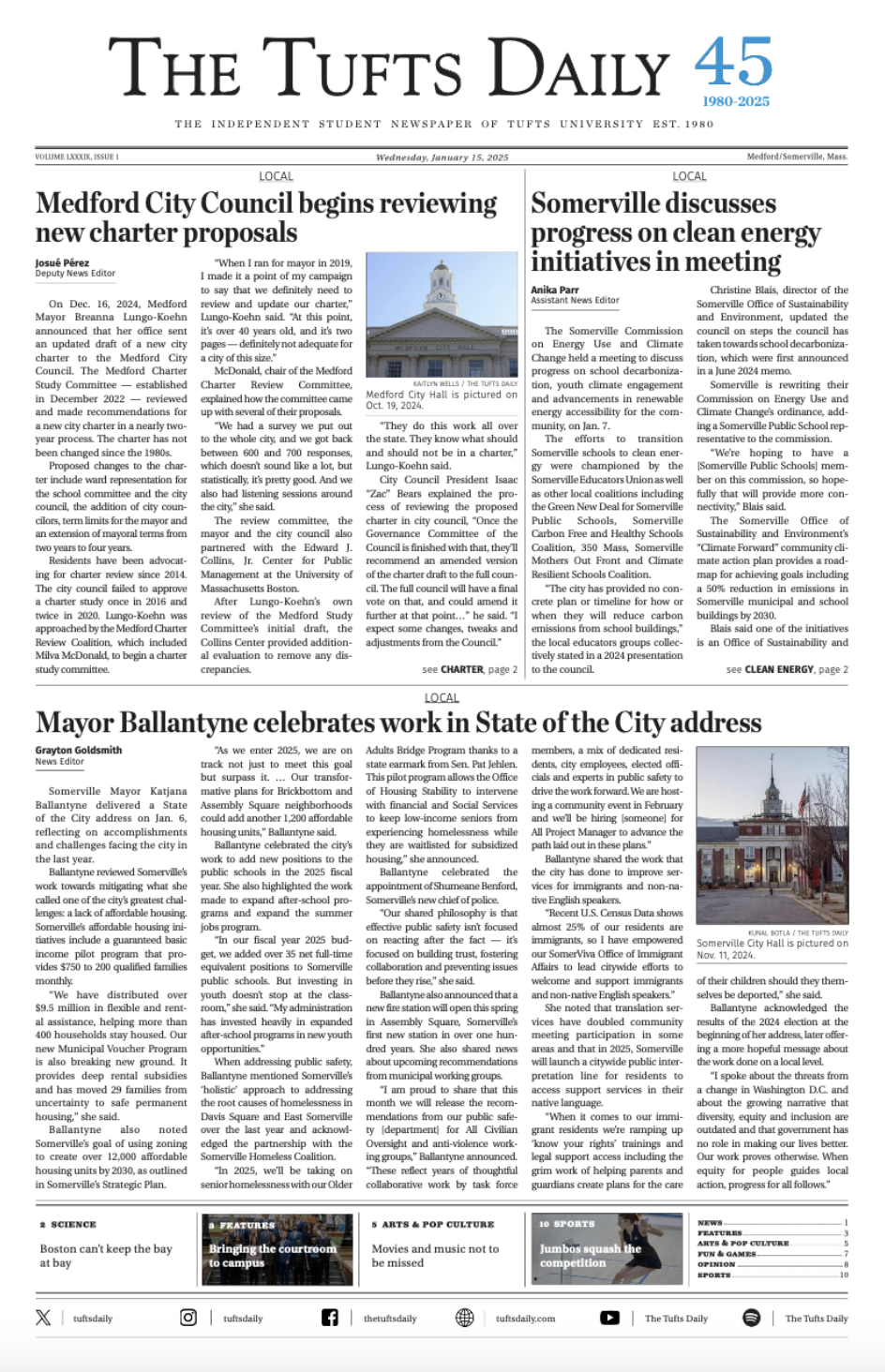The Joyce Cummings Center, the new academic building for which construction has begun near the intersection of Boston Avenue and College Avenue, will not be rated on the Leadership in Energy and Environmental Design (LEED) green building rating system, which recognizes a structure's environmental sustainability, according to Director of Strategic Capital Programs Ruth Bennett.
Many of Tufts’ most recent and high-profile capital projects, including theScience and Engineering Complex, the Collaborative Learning and Innovation Complex at 574 Boston Avenue andSophia Gordon Hall are rated on the LEED green building rating system as part of the University's strategy to pursue sustainable practices and standards.
The LEED system, which was developed by the U.S. Green Building Council, awards projects points on their performance in specific categories, such as materials used in construction, site selection and energy efficiency.
According to the U.S. Green Building Council’s webpage, the highest possible rating is "Platinum" and the lowest "Certified," with "Silver" and "Gold" in between.
Bennett explained that though the Joyce Cummings Center will not be rated on the LEED Green Building Rating System, it will be designed to use the least energy possible.
"We're really trying to focus on the energy consumption, and thereby the carbon emissions of this building to as minimal as we can get it, because that has the most immediate, direct impact on carbon reduction," Bennett said.
Bennett explained what the actual energy consumption target is, and how it could be related to the LEED Green Building Rating System.
“The target is 50 kBtu/sf of energy consumption,” Bennett said. “This is probably 50% more efficient from an energy consumption point of view than a LEED Platinum building.”
Bennett also addressed why Tufts elected to pursue an energy use intensity targeting strategy over a LEED rating.
"You could have a ... high rated LEED building, and you wouldn't be reducing your energy consumption as much as we are," Bennett said.
Jenna Clark, a co-leader of Students for Environmental Awareness with Bridget Moynihan, explained why she believed that pursuing LEED ratings is important for Tufts' buildings.
"LEED certification would allow for a certain level of transparency, allowing Tufts students and the public to know exactly what steps Tufts is taking to address the climate crisis," Clark, a junior, said.
Clark speculated that the university chose not to pursue LEED certification because Tufts felt it wasn't necessary.
"It was our understanding of the rationale for not certifying the building that to Tufts, LEED certification seems unnecessary and costly and that sustainability standards could, and would, still be met," Clark said.
Bennett clarified that though the Cummings Foundation had an active role in the planning of the building, it had no role in determining whether to pursue the energy-use targeting strategy over a LEED rating.
"The Cummings Foundation was involved with us in the design process," Bennett said. "We set the strategy, but they were with us in working towards it."
Bennett added that the decision to not pursue a LEED rating for the Joyce Cummings Center did not mark a departure from a general trend.
"We really are focusing on lowering our carbon emissions, that's a big overall strategic goal," Bennett said. "I wouldn't say that it was a process where the policy was changed, but it was more of a 'this is a more immediate and more integrated strategy for lowering consumption.'"
Director of Government and Community Relations Rocco DiRico highlighted some of the features of the building that form this energy-use target strategy.
“The building will feature triple glazed windows that will cut down on energy consumption … [and] will feature solar panels on the roof,” DiRico said.
DiRico also highlighted the relationship between the Joyce Cummings Center and the new College Avenue station under construction as part of the Massachusetts Bay Transportation Authority (MBTA) Green Line Extension.
“The [Joyce Cummings Center] is a transit-oriented development that will make it easy for people to utilize mass transit,” DiRico said. “The plaza in front of the building will connect to a pedestrian bridge that will allow students, faculty and staff to easily access the MBTA’s new Green Line Extension station that is scheduled to open in 2021.”
The building, which has been in planning as early as2015, will add auditoriums and classrooms, collaborative spaces and faculty offices in the departments of mathematics, computer science and economics, the Gordon Institute, the Fletcher School of Law and Diplomacy’s executive education and global master of arts program and the Center for Applied Brain and Cognitive Studies.
According to Senior Vice President for University Advancement Eric Johnson, the building will be named after Joyce Cummings.
“The building’s formal name will be Joyce Cummings Center,” Johnson said. “Final details on how signs will be done are still to be worked out.”
This resolves differences between the project’s webpage, where it is called the “Tufts Cummings Center,” and signs at the construction site, where it is called the “Tufts Joyce Cummings Center.”
Medford residents expressed frustration in June over the use of a field as a staging area behind the Gantcher Center, called the Stearns Estate Field, according to the Medford Transcript.
However, DiRico reiterated Tufts’ response to the community’s concerns, which were announced at a June community meeting held in Halligan Hall.
“In response to those concerns, Tufts has altered its plan and will be using another area as a temporary staging area,” DiRico said.
Construction began on schedule for the Joyce Cummings Center in June and will be completed in 2021, according to DiRico. Occupancy for the building is scheduled to begin over the summer of 2021.
More from The Tufts Daily





